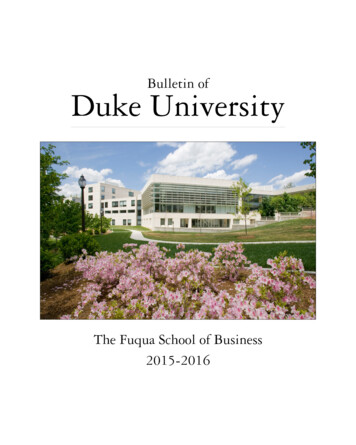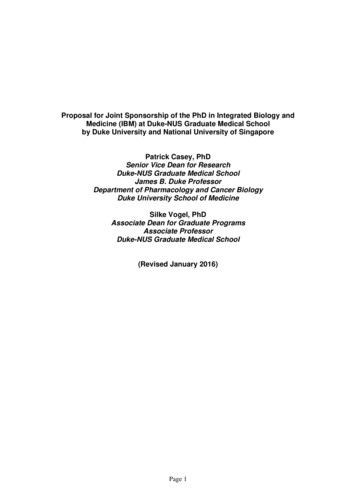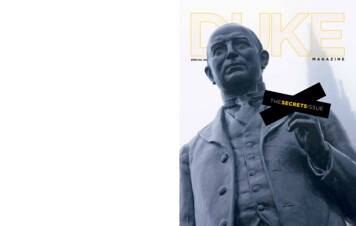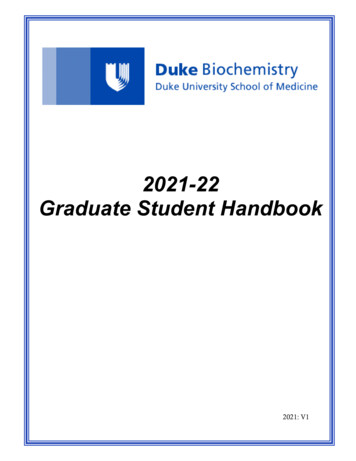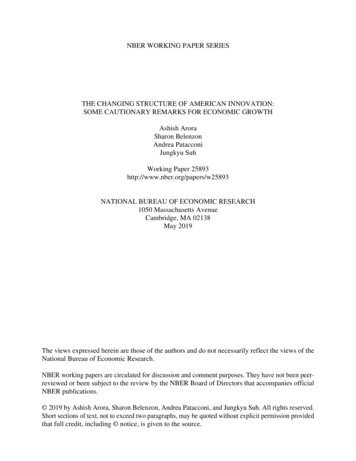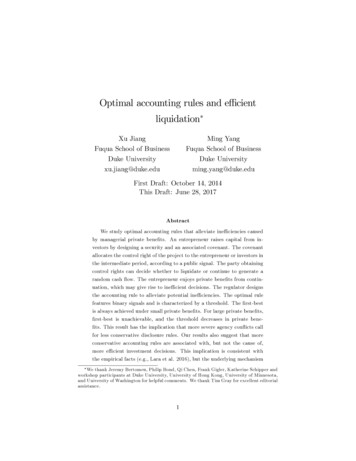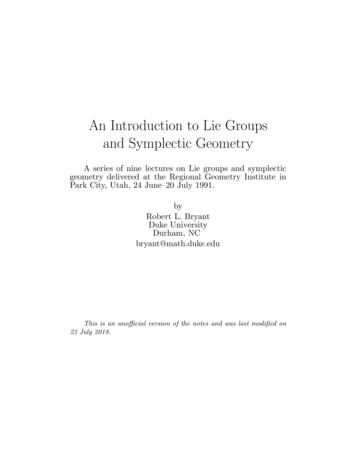
Transcription
An Introduction to Lie Groupsand Symplectic GeometryA series of nine lectures on Lie groups and symplecticgeometry delivered at the Regional Geometry Institute inPark City, Utah, 24 June–20 July 1991.byRobert L. BryantDuke UniversityDurham, NCbryant@math.duke.eduThis is an unofficial version of the notes and was last modified on23 July 2018.
IntroductionThese are the lecture notes for a short course entitled “Introduction to Lie groups andsymplectic geometry” that I gave at the 1991 Regional Geometry Institute at Park City,Utah starting on 24 June and ending on 11 July.The course really was designed to be an introduction, aimed at an audience of students who were familiar with basic constructions in differential topology and rudimentarydifferential geometry, who wanted to get a feel for Lie groups and symplectic geometry.My purpose was not to provide an exhaustive treatment of either Lie groups, which wouldhave been impossible even if I had had an entire year, or of symplectic manifolds, whichhas lately undergone something of a revolution. Instead, I tried to provide an introductionto what I regard as the basic concepts of the two subjects, with an emphasis on examplesthat drove the development of the theory.I deliberately tried to include a few topics that are not part of the mainstream subject,such as Lie’s reduction of order for differential equations and its relation with the notionof a solvable group on the one hand and integration of ODE by quadrature on the other.I also tried, in the later lectures to introduce the reader to some of the global methodsthat are now becoming so important in symplectic geometry. However, a full treatment ofthese topics in the space of nine lectures beginning at the elementary level was beyond myabilities.After the lectures were over, I contemplated reworking these notes into a comprehensive introduction to modern symplectic geometry and, after some soul-searching, finallydecided against this. Thus, I have contented myself with making only minor modificationsand corrections, with the hope that an interested person could read these notes in a fewweeks and get some sense of what the subject was about.An essential feature of the course was the exercise sets. Each set begins with elementary material and works up to more involved and delicate problems. My object was toprovide a path to understanding of the material that could be entered at several differentlevels and so the exercises vary greatly in difficulty. Many of these exercise sets are obviously too long for any person to do them during the three weeks the course, so I providedextensive hints to aid the student in completing the exercises after the course was over.I want to take this opportunity to thank the many people who made helpful suggestions for these notes both during and after the course. Particular thanks goes to KarenUhlenbeck and Dan Freed, who invited me to give an introductory set of lectures at theRGI, and to my course assistant, Tom Ivey, who provided invaluable help and criticism inthe early stages of the notes and tirelessly helped the students with the exercises. Whilethe faults of the presentation are entirely my own, without the help, encouragement, andproofreading contributed by these folks and others, neither these notes nor the coursewould never have come to pass.I.12
Background Material and Basic Terminology. In these lectures, I assume thatthe reader is familiar with the basic notions of manifolds, vector fields, and differentialforms. All manifolds will be assumed to be both second countable and Hausdorff. Also,unless I say otherwise, I generally assume that all maps and manifolds are C .Since it came up several times in the course of the course of the lectures, it is probablyworth emphasizing the following point: A submanifold of a smooth manifold X is, bydefinition, a pair (S, f ) where S is a smooth manifold and f : S X is a one-to-oneimmersion. In particular, f need not be an embedding.The notation I use for smooth manifolds and mappings is fairly standard, but with afew slight variations:If f : X Y is a smooth mapping, then f ′ : T X T Y denotes the induced mappingon tangent bundles, with f ′ (x) denoting its restriction to Tx X. (However, I follow traditionwhen X R and let f ′ (t) stand for f ′ (t)( / t) for all t R. I trust that this abuse ofnotation will not cause confusion.)For any vector space V , I generally use Ap (V ) (instead of, say, Λp (V )) to denotethe space of alternating (or exterior) p-forms on V . For a smooth manifold M , I denotethe space of smooth, alternating p-forms on M by Ap (M ). The algebra of all (smooth)differential forms on M is denoted by A (M ).I generally reserve the letter d for the exterior derivative d: Ap (M ) Ap 1 (M ).For any vector field X on M , I will denote left-hook with X (often called interiorproduct with X) by the symbol X . This is the graded derivation of degree 1 of A (M )that satisfies X (df ) Xf for all smooth functions f on M . For example, the Cartanformula for the Lie derivative of differential forms is written in the formLX φ X dφ d(X φ).Jets. Occasionally, it will be convenient to use the language of jets in describingcertain constructions. Jets provide a coordinate free way to talk about the Taylor expansionof some mapping up to a specified order. No detailed knowledge about these objects willbe needed in these lectures, so the following comments should suffice:If f and g are two smooth maps from a manifold X m to a manifold Y n , we say thatf and g agree to order k at x X if, first, f (x) g(x) y Y and, second, whenu: U Rm and v: V Rn are local coordinate systems centered on x and y respectively,the functions F v f u 1 and G v g u 1 have the same Taylor series at 0 Rm upto and including order k. Using the Chain Rule, it is not hard to show that this conditionis independent of the choice of local coordinates u and v centered at x and y respectively.The notation f x,k g will mean that f and g agree to order k at x. This is easilyseen to define an equivalence relation. Denote the x,k -equivalence class of f by j k (f )(x),and call it the k-jet of f at x.For example, knowing the 1-jet at x of a map f : X Y is equivalent to knowing bothf (x) and the linear map f ′ (x): Tx Tf (x) Y .I.23
The set of k-jets of maps from X to Y is usually denoted by J k (X, Y ). It is not hardto show that J k (X, Y ) can be given a unique smooth manifold structure in such a waythat, for any smooth f : X Y , the obvious map j k (f ): X J k (X, Y ) is also smooth.These jet spaces have various functorial properties that we shall not need at all. Themain reason for introducing this notion is to give meaning to concise statements like “Thecritical points of f are determined by its 1-jet”, “The curvature at x of a Riemannianmetric g is determined by its 2-jet at x”, or, from Lecture 8, “The integrability of analmost complex structure J: T X T X is determined by its 1-jet”. Should the readerwish to learn more about jets, I recommend the first two chapters of [GG].Basic and Semi-Basic. Finally, I use the following terminology: If π: V X isa smooth submersion, a p-form φ Ap (V ) is said to be π-basic if it can be written inthe form φ π (ϕ) for some ϕ Ap (X) and π-semi-basic if, for any π-vertical*vectorfield X, we have X φ 0. When the map π is clear from context, the terms “basic” or“semi-basic” are used.It is an elementary result that if the fibers of π are connected and φ is a p-form on Vwith the property that both φ and dφ are π-semi-basic, then φ is actually π-basic.At least in the early lectures, we will need very little in the way of major theorems,but we will make extensive use of the following results: The Implicit Function Theorem: If f : X Y is a smooth map of manifoldsand y Y is a regular value of f , then f 1 (y) X is a smooth embedded submanifoldof X, withTx f 1 (y) ker(f ′ (x): Tx X Ty Y ) Existence and Uniqueness of Solutions of ODE: If X is a vector field on asmooth manifold M , then there exists an open neighborhood U of {0} M in R M anda smooth mapping F : U M with the following properties:i. F (0, m) m for all m M .ii. For each m M , the slice Um {t R (t, m) U } is an open interval in R(containing 0) and the smooth mapping φm : Um M defined by φm (t) F (t, m) isan integral curve of X.iii. ( Maximality ) If φ: I M is any integral curve of X where I R is an intervalcontaining 0, then I Uφ(0) and φ(t) φφ(0) (t) for all t I.The mapping F is called the (local) flow of X and the open set U is called the domainof the flow of X. If U R M , then we say that X is complete.Two useful properties of this flow are easy consequences of this existence and uniqueness theorem. First, the interval UF (t,m) R is simply the interval Um translated by t.Second, F (s t, m) F (s, F (t, m)) whenever t and s t lie in Um . * A vector field X is π-vertical with respect to a map π: V X if and only if π ′ X(v) 0 for all v VI.34
The Simultaneous Flow-Box Theorem: If X1 , X2 , . . ., Xr are smooth vectorfields on M that satisfy the Lie bracket identities[Xi , Xj ] 0for all i and j, and if p M is a point where the r vectors X1 (p), X2 (p), . . . , Xr (p) arelinearly independent in Tp M , then there exists a local coordinate system x1 , x2 , . . . , xn onan open neighborhood U of p so that, on U ,X1 , x1X2 , x2.,Xr . xrThe Simultaneous Flow-Box Theorem has two particularly useful consequences. Before describing them, we introduce an important concept.Let M be a smooth manifold and let E T M be a smooth subbundle of rank p. Wesay that E is integrable if, for any two vector fields X and Y on M that are sections of E,their Lie bracket [X, Y ] is also a section of E. The Local Frobenius Theorem: If M n is a smooth manifold and E T M isa smooth, integrable sub-bundle of rank r, then every p in M has a neighborhood U onwhich there exist local coordinates x1 , . . . , xr , y 1 , . . . , y n r so that the sections of E overU are spanned by the vector fields , x1 , x2., . xrAssociated to this local theorem is the following global version: The Global Frobenius Theorem: Let M be a smooth manifold and let E T Mbe a smooth, integrable subbundle of rank r. Then for any p M , there exists a connectedr-dimensional submanifold L M that contains p, that satisfies Tq L Eq for all q S,and that is maximal in the sense that any connected r ′ -dimensional submanifold L′ Mthat contains p and satisfies Tq L′ Eq for all q L′ is a submanifold of L.The submanifolds L provided by this theorem are called the leaves of the sub-bundleE. (Some books call a sub-bundle E T M a distribution on M , but I avoid this since“distribution” already has a well-established meaning in analysis.)I.45
Contents1. Introduction: Symmetry and Differential Equations7First notions of differential equations with symmetry, classical “integration methods.”Examples: Motion in a central force field, linear equations, the Riccati equation, andequations for space curves.2. Lie Groups12Lie groups. Examples: Matrix Lie groups. Left-invariant vector fields. The exponential mapping. The Lie bracket. Lie algebras. Subgroups and subalgebras. Classification of the two and three dimensional Lie groups and algebras.3. Group Actions on Manifolds38Actions of Lie groups on manifolds. Orbit and stabilizers. Examples. Lie algebrasof vector fields. Equations of Lie type. Solution by quadrature. Appendix: Lie’sTransformation Groups, I. Appendix: Connections and Curvature.4. Symmetries and Conservation Laws61Particle Lagrangians and Euler-Lagrange equations. Symmetries and conservationlaws: Noether’s Theorem. Hamiltonian formalism. Examples: Geodesics on Riemannian Manifolds, Left-invariant metrics on Lie groups, Rigid Bodies. PoincaréRecurrence.5. Symplectic Manifolds, I80Symplectic Algebra. The structure theorem of Darboux. Examples: Complex Manifolds, Cotangent Bundles, Coadjoint orbits. Symplectic and Hamiltonian vector fields.Involutivity and complete integrability.6. Symplectic Manifolds, II100Obstructions to the existence of a symplectic structure. Rigidity of symplectic structures. Symplectic and Lagrangian submanifolds. Fixed Points of Symplectomorphisms. Appendix: Lie’s Transformation Groups, II7. Classical Reduction116Symplectic manifolds with symmetries. Hamiltonian and Poisson actions. The moment map. Reduction.8. Recent Applications of Reduction128Riemannian holonomy. Kähler Structures. Kähler Reduction. Examples: ProjectiveSpace, Moduli of Flat Connections on Riemann Surfaces. HyperKähler structures andreduction. Examples: Calabi’s Examples.9. The Gromov School of Symplectic Geometry147The Soft Theory: The h-Principle. Gromov’s Immersion and Embedding Theorems.Almost-complex structures on symplectic manifolds. The Hard Theory: Area estimates, pseudo-holomorphic curves, and Gromov’s compactness theorem. A sample ofthe new results.I.16
Lecture 1:Introduction: Symmetry and Differential EquationsConsider the classical equations of motion for a particle in a conservative force fieldẍ grad V (x),where V : Rn R is some function on Rn . If V is proper (i.e. the inverse image under Vof a compact set is compact, as when V (x) x 2 ), then, to a first approximation, V is thepotential for the motion of a ball of unit mass rolling around in a cup, moving only underthe influence of gravity. For a general function V we have only the grossest knowledge ofhow the solutions to this equation ought to behave.Nevertheless, we can say a few things. The total energy ( kinetic plus potential)is given by the formula E 12 ẋ 2 V (x) and is easily shown to be constant on anysolution (just differentiate E x(t) and use the equation). Since, V is proper, it follows 1that x must stay inside a compact set V[0, E(x(0))] , and so the orbits are bounded.Without knowing any more about V , one can show (see Lecture 4 for a precise statement)that the motion has a certain ‘recurrent’ behaviour: The trajectory resulting from ‘most’initial positions and velocities tends to return, infinitely often, to a small neighborhoodof the initial position and velocity. Beyond this, very little is known is known about thebehaviour of the trajectories for generic V .Suppose now that the potential function V is rotationally symmetric, i.e., that Vdepends only on the distance from the origin and, for the sake of simplicity, let us taken 3 as well. This is classically called the case of a central force field in space. If we letV (x) 21 v( x 2 ), then the equations of motion become ẍ v ′ x 2 x.As conserved quantities, i.e., functions of the position and velocity that stay constant onany solution of the equation, we still have the energy E 12 ẋ 2 v( x 2 ) , but is it alsoeasy to see that the vector-valued function x ẋ is conserved, sinced(x ẋ) ẋ ẋ x v ′ ( x 2 ) x 0 0 0.dtCall this vector-valued function µ. We can think of E and µ as functions on the phasespace R6 . For generic values of E0 and µ0 , the simultaneous level setΣE0 ,µ0 { (x, ẋ) E(x, ẋ) E0 , µ(x, ẋ) µ0 }of these functions is a surface ΣE0 ,µ0 R6 , and any integral of the equations of motionmust lie in one of these surfaces. Since we know a great deal about integrals of ODEs onL.1.17
surfaces, this problem is very tractable. (See Lecture 4 and its exercises for more detailson this.)The function µ, known as the angular momentum, is called a first integral of thesecond-order ODE for x(t) and seems to somehow correspond to the rotational symmetryof the original ODE. This vague relationship will be considerably sharpened and madeprecise in the upcoming lectures.The relationship between symmetry and solvability in differential equations is profound and far reaching. The subjects that are now known as ‘Lie groups’ and ‘symplecticgeometry’ got their beginnings from the study of symmetries of systems of ordinary differential equations and of integration techniques for them.By the middle of the nineteenth century, Galois theory had clarified the relationshipbetween the solvability of polynomial equations by radicals and the group of ‘symmetries’of the equations. Sophus Lie set out to do the same thing for differential equations andtheir symmetries.Here is a ‘dictionary’ showing the (rough) correspondence that Lie developed betweenthese two achievements of nineteenth century mathematics.Galois theoryfinite groupspolynomial equationssolvable by radicalsinfinitesimal symmetriescontinuous groupsdifferential equationssolvable by quadratureAlthough the full explanation of these correspondances must await the later lectures, wecan at least begin the story in the simplest examples as motivation for developing thegeneral theory. This is what I shall do for the rest of today’s lecture.Classical Integration Techniques. The very simplest ordinary differential equationthat we ever encounter is the equation(1)ẋ(t) α(t)where α is a known function of t. The solution of this differential equation is simplyZ xx(t) x0 α(τ ) dτ.0The process of computing an integral was known as ‘quadrature’ in the classical literature(a reference to expressing the area under a curve as the area of a quadrilateral), so it wassaid that (1) was ‘solvable by quadrature’. Note that, once one finds a particular solution,all of the others are got by simply translating the particular solution by a constant, in thiscase, by x0 . Alternatively, one could say that the equation (1) itself was invariant under‘translation in x’.The next most trivial case is the homogeneous linear equation(2)L.1.2ẋ β(t) x.8
This equation is invariant under scale transformations x 7 rx. Since the mappinglog: R R converts scaling to translation, it should not be surprising that the differentialequation (2) is also solvable by a quadrature:Rtβ(τ ) dτx(t) x0 e 0.Note that, again, the symmetries of the equation suffice to allow us to deduce the generalsolution from a particular one.Next, consider an equation where the right hand side is an affine function of x,(3)ẋ α(t) β(t) x.This equation is still solvable in full generality, using two quadratures. For, if we set RtRtβ(τ )dτx(t) u(t)e 0,β(τ )dτ, which can be solved for u by another quadrature. It isthen u satisfies u̇ α(t)e 0not at all clear why one can somehow ‘combine’ equations (1) and (2) and get an equationthat is still solvable by quadrature, but this will become clear in Lecture 3.Now consider an equation with a quadratic right-hand side, the so-called Riccati equation:(4)ẋ α(t) 2β(t)x γ(t)x2 .It can be shown that there is no method for solving this by quadratures and algebraicmanipulations alone. However, there is a way of obtaining the general solution from aparticular solution: If s(t) is a particular solution of (4), try the ansatz x(t) s(t) 1/u(t). The resulting differential equation for u has the form (3) and hence is solvable byquadratures.The Riccati equation (4) has an extensive history, and we will return to it often. Itsremarkable property, that given one solution we can obtain the general solution, should becontrasted with the case of(5)ẋ α(t) β(t) x γ(t) x2 δ(t) x3 .For equation (5), knowing one solution does not help give the rest of the solutions. Thereis in fact a world of difference between this and the Riccati equation, although this is farfrom evident looking at them.Before leaving these simple ODE, we note the following curious progression: If x1 andx2 are solutions of an equation of type (1), then clearly the difference x1 x2 is constant.Similarly, if x1 and x2 6 0 are solutions of an equation of type (2), then the ratio x1 /x2is constant. Furthermore, if x1 , x2 , and x3 6 x1 are solutions of an equation of type (3),L.1.39
then the expression (x1 x2 )/(x1 x3 ) is constant. Finally, if x1 , x2 , x3 6 x1 , and x4 6 x2are solutions of an equation of type (4), then the cross-ratio(x1 x2 )(x4 x3 )(x1 x3 )(x4 x2 )is constant. There is no such corresponding expression (for any number of particularsolutions) for equations of type (5). The reason for this will be made clear in Lecture 3.For right now, we just want to remark on the fact that the linear fractional transformationsof the real line, a group isomorphic to SL(2, R), are exactly the transformations that leavefixed the cross-ratio of any four points. As we shall see, the group SL(2, R) is closelyconnected with the Riccati equation and it is this connection that accounts for many ofthe special features of this equation.We will conclude this lecture by discussing the group of rigid motions in Euclidean3-space. These are transformations of the formT (x) R x t,where R is a rotation in E3 and t E3 is any vector. It is easy to check that the set ofrigid motions form a group under composition that is, in fact, isomorphic to the group of4-by-4 matrices R t3tR R I3 , t R.0 1(Topologically, the group of rigid motions is just the product O(3) R3 .)Now, suppose that we are asked to solve for a curve x: R R3 with a prescribedcurvature κ(t) and torsion τ (t). If x were such a curve, then we could calculate thecurvature and torsion by defining an oriented orthonormal basis (e1 ,e2 ,e3 ) along the curve,satisfying ẋ e1 , ė1 κe2 , ė2 κe1 τ e3 . (Think of the torsion as measuring how e2falls away from the e1 e2 -plane.) Form the 4-by-4 matrixX e10e20e30x1 ,(where we always think of vectors in R3 as columns). Then we can express the ODE forprescribed curvature and torsion as 0 κ 0 κ 0 τẊ X 0 τ00 00 10 .00We can think of this as a linear system of equations for a curve X(t) in the group of rigidmotions.L.1.410
It is going to turn out that, just as in the case of the Riccati equation, the prescribedcurvature and torsion equations cannot be solved by algebraic manipulations and quadrature alone. However, once we know one solution, all other solutions for that particularκ(t), τ (t) can be obtained by rigid motions. In fact, though, we are going to see that onedoes not have to know a solution to the full set of equations before finding the rest of thesolutions by quadrature, but only a solution to an equation connected to SO(3), just in thesame way that the Riccati equation is connected to SL(2, R), the group of transformationsof the line that fix the cross-ratio of four points.L.1.511
Lecture 2:Lie Groups and Lie AlgebrasLie Groups. In this lecture, I define and develop some of the basic properties of thecentral objects of interest in these lectures: Lie groups and Lie algebras.Definition 1: A Lie group is a pair (G, µ) where G is a smooth manifold and µ : G G Gis a smooth mapping that gives G the structure of a group.When the multiplication µ is clear from context, one usually just says “G is a Liegroup.” Also, for the sake of notational sanity, I will follow the practice of writing µ(a, b)simply as ab whenever this will not cause confusion. I will usually denote the multiplicativeidentity by e G and the multiplicative inverse of a G by a 1 G.Most of the algebraic constructions in the theory of abstract groups have straightforward analogues for Lie groups:Definition 2: A Lie subgroup of a Lie group G is a subgroup H G that is also asubmanifold of G. A Lie group homomorphism is a group homomorphism φ : H G thatis also a smooth mapping of the underlying manifolds.Here is the prototypical example of a Lie group:Example : The General Linear Group. The (real) general linear group in dimension n, denoted GL(n, R), is the set of invertible n-by-n real matrices regarded as an opensubmanifold of the n2 -dimensional vector space of all n-by-n real matrices with multiplication map µ given by matrix multiplication: µ(a, b) ab. Since the matrix product abis defined by a formula that is polynomial in the matrix entries of a and b, it is clearthat GL(n, R) is a Lie group.Actually, if V is any finite dimensional real vector space, then GL(V ), the set ofbijective linear maps φ : V V , is an open subset of the vector space End(V ) V V and becomes a Lie group with multiplication µ : GL(V ) GL(V ) GL(V ) given bycomposition of maps: µ(φ1 , φ2 ) φ1 φ2 . If dim(V ) n, then GL(V ) is isomorphic (as aLie group) to GL(n, R), though not canonically.The advantage of considering abstract vector spaces V rather than just Rn is mainlyconceptual, but, as will be seen, this conceptual advantage is great. In fact, Lie groups oflinear transformations are so fundamental that a special terminology is reserved for them:Definition 3: A (linear) representation of a Lie group G is a Lie group homomorphism ρ : G GL(V ) for some vector space V (called the representation space). Sucha representation is said to be faithful (resp., almost faithful) if ρ is one-to-one (resp., has0-dimensional kernel).L.2.112
It is a consequence of a theorem of Ado and Iwasawa that every connected Lie grouphas an almost faithful, finite-dimensional representation. (One of the later exercises constructs a connected Lie group that has no faithful, finite-dimensional representation, soalmost faithful is the best one can hope for.)Example: Vector Spaces. Any vector space over R becomes a Lie group when thegroup “multiplication” is taken to be addition.Example: Matrix Lie Groups. The Lie subgroups of GL(n, R) are called matrix Liegroups and play an important role in the theory. Not only are they the most frequentlyencountered, but, because of the theorem of Ado and Iwasawa, practically anything that istrue for matrix Lie groups has an analog for a general Lie group. In fact, for the first passthrough, the reader can simply imagine that all of the Lie groups mentioned are matrixLie groups. Here are a few simple examples:1. Let An be the set of diagonal n-by-n matrices with positive entries on the diagonal.2. Let Nn be the set of upper triangular n-by-n matrices with all diagonal entries allequal to 1.no 3. (n 2 only) Let C ba ba a2 b2 0 . Then C is a matrix Lie group diffeomorphic to S 1 R. (You should check that this is actually a subgroup of GL(2, R)!)4. Let GL (n, R) {a GL(n, R) det(a) 0}There are more interesting examples, of course. A few of these areSL(n, R) {a GL(n, R) det(a) 1}O(n) {a GL(n, R) ta a In }SO(n, R) {a O(n) det(a) 1},which are known respectively as the special linear group , the orthogonal group , and thespecial orthogonal group in dimension n. In each case, one must check that the givensubset is actually a subgroup and submanifold of GL(n, R). These are exercises for thereader. (See the problems at the end of this lecture for hints.)A Lie group can have ‘wild’ subgroups that cannot be given the structure of a Liegroup. For example, (R, ) is a Lie group that contains totally disconnected, uncountablesubgroups. Since all manifolds in these notes are second countable, such subgroups (bydefinition) cannot be given the structure of a (0-dimensional) Lie group.However, it can be shown [see Warner, pg. 110] that any closed subgroup of a Liegroup G is an embedded submanifold of G and hence is a Lie subgroup. However, forreasons that will soon become apparent, it is disadvantageous to consider only closedsubgroups.L.2.213
Example: A non-closed subgroup. For example, even GL(n, R) can have Liesubgroups that are not closed. Here is a simple example: Let λ be any irrational realnumber and define a homomorphism φλ : R GL(4, R) by the formula cos t sin tφλ (t) 00 sin tcos t0000cos λtsin λt 00 sin λtcos λtThen φλ is easily seen to be a one-to-one immersion so its image is a submanifold Gλ GL(4, R), which is therefore a Lie subgroup. It is not hard to see that cos t sin tGλ 0 0 sin t0cos t00cos s0sin s 0 0 s,t R. sin s cos sNote that Gλ is diffeomorphic to R while its closure in GL(4, R) is diffeomorphic to S 1 S 1 !It is also useful to consider matrix Lie groups with complex coefficients. However,complex matrix Lie groups are really no more general than real matrix Lie groups (thoughthey may be more convenient to work with). To see why, note that one can write acomplex n-by-n matrixA Bi (where A and B are real n-by-n matrices) as the 2n-by A B2n matrix B A . In this way, one can embed GL(n, C), the space of n-by-n invertiblecomplex matrices, as a closed submanifold of GL(2n, R). The reader should check thatthis mapping is actually a group homomorphism.Among the more commonly encountered complex matrix Lie groups are the complexspecial linear group, denoted by SL(n, C), and the unitary and special unitary groups,denoted, respectively, asU(n) {a GL(n, C) a a In }SU(n) {a U(n) detC (a) 1 }where a tā is the Hermitian adjoint of a. These groups will play an important role inwhat follows. One may want to familiarize oneself with these groups by doing some of theexercises for this section.Basic General Properties. If G is a Lie group with a G, let La , Ra : G Gdenote the smooth mappings defined byLa (b) abandRa (b) ba.Proposition 1: For any Lie group G, the maps La and Ra are diffeomorphisms, the mapµ : G G G is a submersion, and the inverse mapping ι : G G defined by ι(a) a 1is smooth.L.2.314
Proof: By the axioms of group multiplication, La 1 is both a left and right inverse toLa . Since (La ) 1 exists and is smooth, La is a diffeomorphism. The argument for Ra issimilar.In particular, L′a : T G T G induces an isomorphism of tangent spaces Tb G Tab G′for all b G and Ra : T G T G induces an isomorphism of tangent spaces Tb G Tba Gfor all b G. Using the natural identification T(a,b) G G Ta G Tb G, the formula forµ′ (a, b) : T(a,b) G G Tab G is readily seen to beµ′ (a, b)(v, w) L′a (w) Rb′ (v)for all v Ta G and w Tb G. In particular µ′ (a, b) is surjective for all (a, b) G G, soµ : G G G is a submer
such as Lie's reduction of order for differential equations and its relation with the notion of a solvable group on the one hand and integration of ODE by quadrature on the other. I also tried, in the later lectures to introduce the reader to some of the global methods that are now becoming so important in symplectic geometry.
